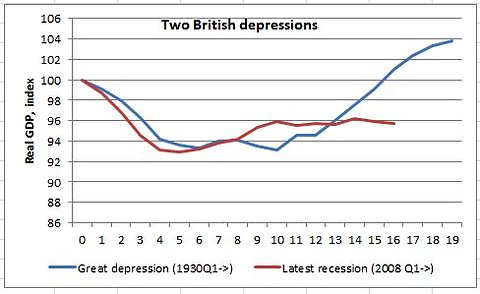Despite the rise of right-leaning economics ideology, reality stubbornly retains its liberal bias, with further evidence today coming from the latest UK economic figures:
The UK economy has returned to recession, after shrinking by 0.2% in the first three months of 2012.
A sharp fall in construction output was behind the surprise contraction, the Office for National Statistics said.
"The huge cuts to public spending - 25% in public sector housing and 24% in public non-housing and with a further 10% cuts to both anticipated for 2013 - have left a hole too big for other sectors to fill," said Judy Lowe, deputy chairman of industry body CITB-ConstructionSkills, said.
Or, as Krugman points out, the Conservative's austerity measures have worked no better in the UK than anywhere else in the world:

Now Britain is officially in double-dip recession, and has achieved the remarkable feat of doing worse this time around than it did in the 1930s.
Now, the defense I hear from Cameron apologists is that the austerity mostly hasn’t even hit yet. But that’s really not much of a defense. Remember, the austerity was supposed to work by inspiring confidence; where’s the confidence? Basically, the expansionary aspect should already have kicked in; it’s all contraction from here.
Needless to say, Cameron and Osborne insist that they will not change course, which means that Britain will continue on a death spiral of self-defeating austerity.
It's amazing, really, how Keynes looked back at the Great Depression and learned something, which the right have forgotten for ideological reasons. It's simple: the way out of a recession is for governments to borrow money to get people back to work. This causes growth. The government can then pay back the money when revenues rise because of that growth. Right now, with real interest rates around –4% (yes, minus four), people will actually pay the US government to lend it money. The UK is in a similar situation.
So: the way for the West to get out of the recession is pretty clear, and today's UK GDP growth numbers confirm it. But politicians in most of the world don't believe the facts before them yet. And the recession drags on.